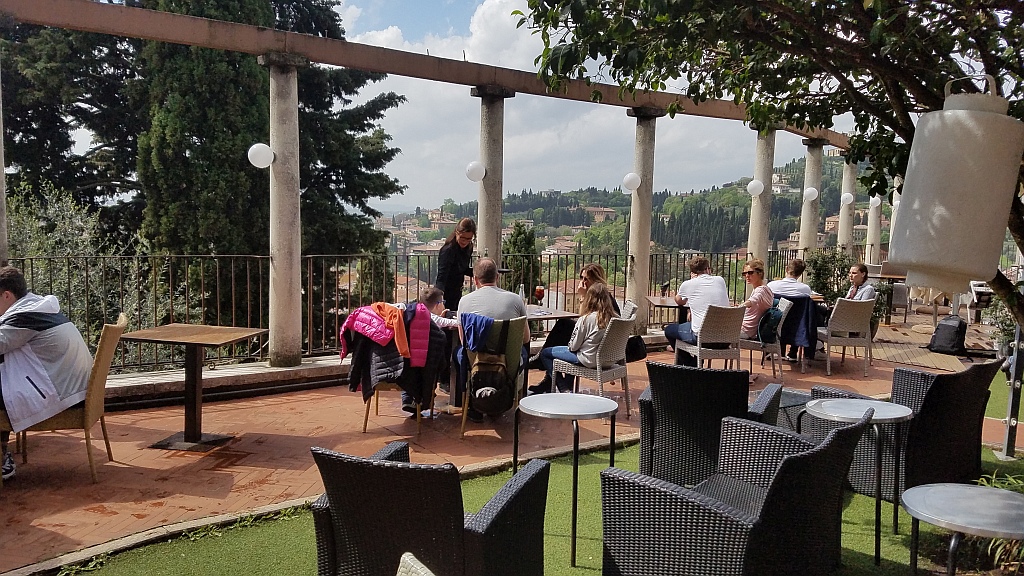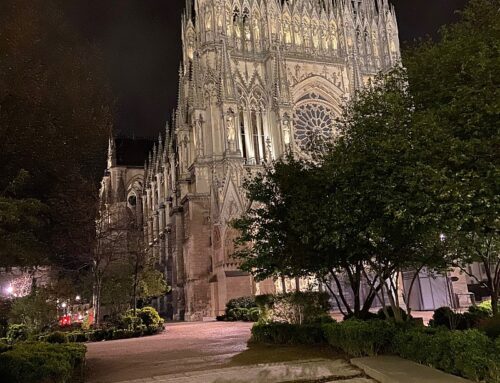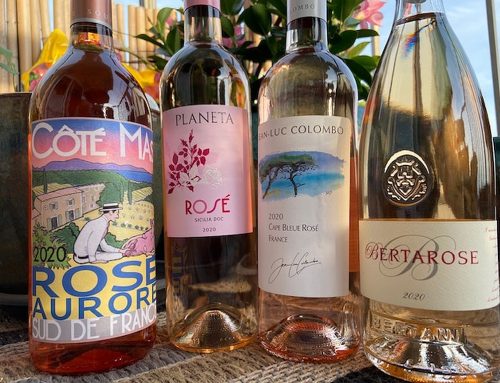This report combines visits in April and October 2019.
Verona may be better known as the city of Romeo and Juliet, but anyone visiting this city in Italy’s Veneto region, will fall in love…with its dining.
One place that will seduce you is TeodoricoRe, perched about 300 feet above the city’s Roman amphitheater and Adige River. It’s an uphill climb on a corkscrew-like street, to the San Pietro Castle, where along the outside wall, a flight of steps descends to TeodoricoRe’s garden terrace, the perfect place for lunch.
Its casual atmosphere belies its professional approach to high-quality organic food products and a broad range of wines. If the sun is shining, it’s easy to forget about the time as I did on a warm April day while enjoying a plate of prosciutto, salami and cheeses, followed by a light-as-air pizza crust with artichokes, mascarpone cheese and pork sausage. I washed it all down with Monte Alto Franciacorta Rose Pas Dosage (zero).
I returned to the terrace on a windy, cloudy October afternoon for a hardy green lasagna with donkey and parmesan ragout, and a plate of speck, coppa al Amarone and prosciutto Montanaro. Both dishes were good companions to the 2018 Tedeschi Valpolicella Classico Lucchine.
The Michelin-star Il Desco restaurant lies inside Verona’s ancient walls and is owned by the Rizzo family. Today it’s directed by the current, young generation, Matteo, whose father is the chef.
I settled into the posh dining room chair with a flute of Champagne, and was further cuddled with an amuse-bouche of passionfruit and citrus in a yogurt mold—a well-married pairing of flavor and texture.
Finishing the Champagne, I looked up from the encyclopedic wine book and ordered a bottle of Occhipinti Il Frappato di Vittoria, a Sicilian red wine made by one of my favorite producers. Its light body and bright, tart-cherry fruit flavor flowed with the subtle and silk-textured sliced duck breast I ordered, and again with the black spaghettini with squid, avocado oil and sliced cherry tomatoes chosen from the a la carte menu.
When I returned in October, I was game for the chef’s autumn selections. I started with a roasted quail seasoned with oregano on a bed of spinach, then a roasted pigeon breast with sweet and sour purple cabbage. The sommelier brought a 2011 Quintarelli Valpolicella Classico Superiore. Its refined texture, pronounced black-cherry taste, integrated tannins and cranberry-like acidity was a great combination with the land fowl, and reminded me of why I love dining in autumn.
Antica Bottega del Vino is an institution in Verona known by its shortened name, Bottega del Vino. Since 2011, an association of 13 winery owners in the Valpolicella Classico area, under the trade umbrella Historical Families, have owned the iconic restaurant in partnership with Antica Rinomata Riseria Ferron, a family producing Carnaroli and the Vialone Nano Veronese rice used for risotto.
This wine mecca dates back centuries; Its wooden bar, tables and chairs are worn from the hundreds of thousands of wine aficionados that have consumed millions of gallons of wine there. Don’t expect polished service or refined food, but be prepared to drink some of the best wines in Italy and eat marvelous rustic foods that marry perfectly with the vast wine selections (many available by the glass).
If you are a party of 10, or thereabouts, ask if the private room in the cellar is available. Lined wall-to-wall with wines (including sideboards and dressers) and lit by candles and chandeliers, you’ll probably never experience another cozy wine nest like it.
At the rear of the 12 Apostoli dining room is a private room and cellar where a staircase descends into an area of Roman ruins. The Gioco family didn’t now about it when they purchased the property in 1920, but when they wanted to expand in the late 1980s, they discovered a wall of a sacred temple from the time of Christ, a portion of a Roman court, and the foundation of a medieval tower, and preserved them for your viewing.
Today the Michelin-star restaurant is under the leadership of fourth-generation, 33-year-old Filippo Gioco, who, along with 40-year-old chef Mauro Buffo’s menu and theatrical dining room lighting, has made it one of the most contemporary dining destinations in Verona.
The 12 tables are widely spaced through the two rooms, giving diners privacy rarely found in most restaurants. Diners can choose among four prix-fixe menus: three offered at 90 euros for three courses, and the fourth at 110 euros for 12 courses. The latter was described as a “collection of 12 tastes, without too much logic, from the other tasting menus.” In April, I opted for two plates a la carte at 30 euros each.
My first dish was a delicious buckwheat pasta with morels and goose in a divine mushroom broth. It was both a statement to healthy eating and a redefinition of what a pasta presentation could be. It was followed by a less-successful squab with béarnaise sauce accompanied by corn and boiled potatoes that offered nothing to the flavorful roasted bird.
At my second dinner, the béarnaise sauce reappeared on an appetizer of eel. Alone the eel was tasty, but the béarnaise was a distraction as it was to the squab. However, that was wiped away by the delicious lime-flavored 2017 Schioppetto Sauvignon, whose richness and depth make Schioppetto white wines a reference point in Friuli and Italy at large. Pappardelle with donkey stew was ideal for a chilly autumn night and was uplifted by 2016 Foradori Morei Teroldego, a red wine with the richness and peppery pop of syrah and the tannin structure of young Burgundy pinot noir.
Unknown to most wine consumers, Foradori produces biodynamic wines from vineyards in the Dolomites that will reward your search for them. As an aside, the wine list at 12 Apostoli is its own statement on Filippo Gioco’s drive to have his restaurant on the cutting-edge of Italian dining.
Trattoria Tre Marchetti sits around the corner from the Roman amphitheater where opera is performed from spring through autumn. The restaurant is a stage any opera director would be proud of. The two dining rooms are an eye-appealing mix of Murano glass chandeliers, turquoise walls, mirrors, paintings, and tables dressed with white tablecloth, classic candlesticks holding tapered candles, colored-glass and gold edged water glasses, and bouquet of flowers.
Though the menu seems to be stuck in the 1960s, you can choose between two five-course prix-fixe menus, one devoted to meat at 55 euros, the other focused on fish at 65 euros. You can order a la carte, too.
In April, my meat menu began with a plate of salami, pork sausage, prosciutto, mushrooms with polenta, and beans. It was enjoyable with Trentino’s best sparkling wine, the very reasonably priced Ferrari Perle Brut. The second course of pappardelle with hare was too one-dimensional. It needed a boost. My main dish of pork was cut into thin strips that reminded me of Chinese presentations, but at Tre Marchetti it was masked with a sweet honey-like sauce and served with celery, potatoes and Brussel sprouts. The puff pastry with dark chocolate was boring. This was a performance that needed a new cast.
Act two in October was better. It started with the world’s greatest mushroom: white truffle. A large, generous shaving coated my tagliatelle—at half the cost of what I would pay in Alba, considered the spiritual home of the truffle. It was followed by perfectly al dente maccheroni with duck sauce that was wonderful with the 2014 Ca’Frui Corte Sant’ Alda Valpolicella. Producer Marinella Camerani made a full-bodied wine with intense, rich blackberry flavor fathoms deep (certified organic and biodynamic). The only off note was, again, the pork: alternate pieces were tough or tender. It appeared the meat was pre-cooked. The tiramisu was a tsunami of cream and cocoa. It didn’t receive a curtain call.
Though I visited a few centuries after Shakespeare’s young lovers, I could sense how the city provided a backdrop for a romantic tale. My dining experiences here ranged from “love at first sight” to “nice meeting you.” Either way, leaving Verona, I thought of Juliet’s farewell, “Parting is such sweet sorrow.”
Next: Part Three, Dining in Ferrara.
Photos by John Foy












Leave A Comment